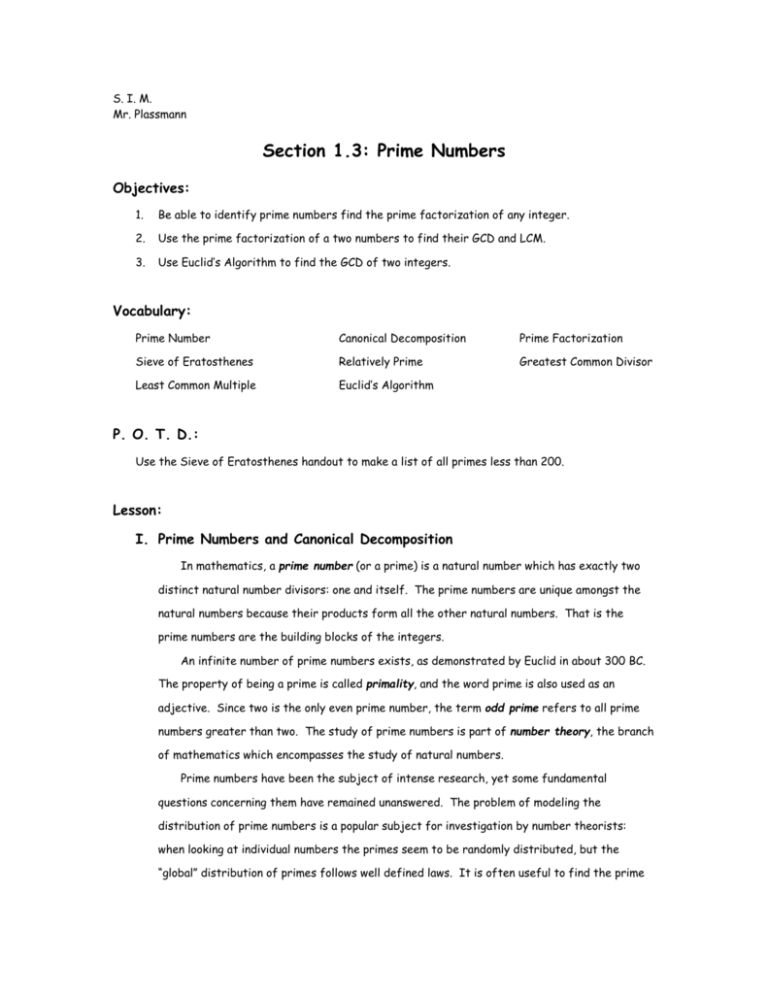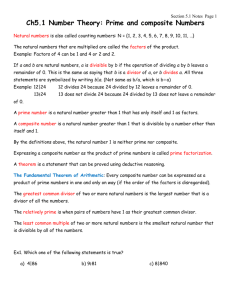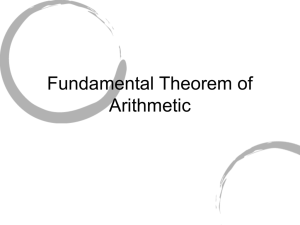Section 1.3 Prime Numbers
advertisement

S. I. M. Mr. Plassmann Section 1.3: Prime Numbers Objectives: 1. Be able to identify prime numbers find the prime factorization of any integer. 2. Use the prime factorization of a two numbers to find their GCD and LCM. 3. Use Euclid’s Algorithm to find the GCD of two integers. Vocabulary: Prime Number Canonical Decomposition Prime Factorization Sieve of Eratosthenes Relatively Prime Greatest Common Divisor Least Common Multiple Euclid’s Algorithm P. O. T. D.: Use the Sieve of Eratosthenes handout to make a list of all primes less than 200. Lesson: I. Prime Numbers and Canonical Decomposition In mathematics, a prime number (or a prime) is a natural number which has exactly two distinct natural number divisors: one and itself. The prime numbers are unique amongst the natural numbers because their products form all the other natural numbers. That is the prime numbers are the building blocks of the integers. An infinite number of prime numbers exists, as demonstrated by Euclid in about 300 BC. The property of being a prime is called primality, and the word prime is also used as an adjective. Since two is the only even prime number, the term odd prime refers to all prime numbers greater than two. The study of prime numbers is part of number theory, the branch of mathematics which encompasses the study of natural numbers. Prime numbers have been the subject of intense research, yet some fundamental questions concerning them have remained unanswered. The problem of modeling the distribution of prime numbers is a popular subject for investigation by number theorists: when looking at individual numbers the primes seem to be randomly distributed, but the “global” distribution of primes follows well defined laws. It is often useful to find the prime factorization of an integer, which is also known as the prime or canonical decomposition of a number. Example #1: Finding the Canonical Decomposition of an Integer Find the prime factorization of the following numbers: A. B. 504 From the factorization of 504 C. 32,513 457 above, can you determine the number of divisors it has? That is, how many numbers is it divisible by. II. Uses of Canonical Decomposition We can use the prime factorization of integers to find many different properties of two different integers. Two of the most important are known as the Least Common Multiple (LCM) and the Greatest Common Divisor (GCD). Definition of Least Common Multiple: The Least Common Multiple of a pair of integers divisible by both a and a and b is the smallest number c that is b. Definiton of Greatest Common Divisor: The Greatest Common Divisor of a pair of integers divides both a and a and b is the largest number c that b. Example #2: Finding the LCM and GCD of a Pair of Integers Use the prime factorizations of the integers below to find their LCM and GCD. A. 84 and 198 B. 110 and 273 Two integers that have a GCD of 1 are said to be relatively prime, that is they have no prime factors in common. III. Euclid’s Algorithm In number theory, the Euclidean Algorithm (also called Euclid’s Algorithm) is an algorithm to determine the greatest common divisor of two integers. The algorithm is attributed to the Greek mathematician Euclid of the third century BC. He is known as “The Father of Geometry” and is credited with helping to lay the foundation of modern mathematics and geometry. The major significance of his algorithm is that it does not require factoring the two integers, and it is also significant in that it is one of the oldest algorithms known. Below the algorithm is used to find the GCD of 527 and 713 . 713 527 1 186 527 186 2 155 186 155 1 31 155 31 50 Example #3: Using Euclid’s Algorithm to find the GCD of Two Integers Use Euclid’s Algorithm to find the GCD of 7469 and 2464 . IV. Homework Assignment 1.3 PRACTICE PROBLEMS: 1. Find the prime factorization of the following numbers. Use the prime factorization to determine the number A. 2. B. 623 13,531 Use the prime factorizations of the integers below to find their LCM and GCD. A. 4. of divisors of each number: 350 and 805 Use Euclid’s Algorithm to find the GCD of B. 496 442 and and 381. 1, 240 S. I. M. Mr. Plassmann NAME:____________________ DATE:____________________ BLOCK:___________________ Section 1.3 Homework: Prime Numbers 1. Find the prime factorization of the following numbers. Use the prime factorization to determine the number A. of divisors of each number: B. 825 22, 064 2. Use the prime factorizations of the integers below to find their LCM and GCD. A. 312 and 473 3. Use Euclid’s Algorithm to find the GCD of B. 373 45 , 120 , and 3, 473 . and 75







